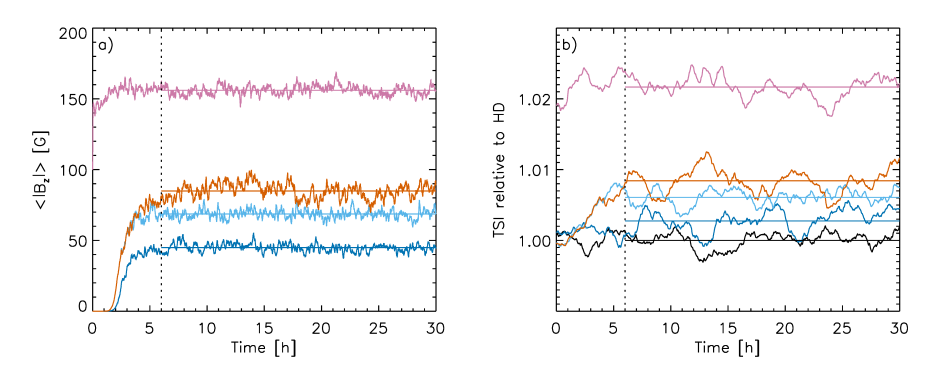Publication Name: ApJ; First HAO Author's Name: M. Rempel
While the quiet Sun magnetic field shows only little variation with the solar cycle, long-term variations cannot be completely ruled out from first principles. We investigate the potential effect of quiet Sun magnetism on spectral solar irradiance through a series of small-scale dynamo simulations with zero vertical flux imbalance (⟨Bz ⟩ = 0) and varying levels of small-scale magnetic field strength, and one weak network case with an additional flux imbalance corresponding to a flux density of ⟨Bz⟩ = 100 G.

Panel (a): Time evolution of the mean vertical magnetic field strength ⟨|Bz|⟩τ=1 for the setups SSD_WEAK (dark blue), SSD_QS (light blue), SSD_Strong (orange), and N100 (magenta). All cases were started at t = 0 hours from the same HD snapshot (with different magnetic initial states). Panel (b): Time evolution of the outgoing radiative energy flux for the setups (1) - (5). The HD case is shown in black. We consider 24 hour averages as indicated in the figure. In the right panel we apply a 2 hour running boxcar average for better readability, since short-term TSI fluctuations have amplitudes of 1 − 2%. These simulations provide a TSI sensitivity of 0.14% for each 10 G of average vertical magnetic field strength in the photosphere at an optical depth of 1.
From these setups we compute the dependence of the outgoing radiative energy flux on the mean vertical magnetic field strength in the photosphere at continuum optical depth τ = 1 (⟨|Bz|⟩τ=1). We find that a quiet Sun setup with a mean vertical field strength of ⟨|Bz|⟩τ=1 = 69 G is about 0.6 % brighter than a non-magnetic reference case. We find a linear dependence of the outgoing radiative energy flux on the mean field strength ⟨|Bz|⟩τ=1 with a relative slope of 1.4 · 10^{−4} G^{−1}. With this sensitivity, only a moderate change of the quiet Sun field strength by 10% would lead to a total solar irradiance variation comparable to the observed solar cycle variation. While this does provide strong indirect constraints on possible quiet Sun variations during a regular solar cycle, it also emphasizes that potential variability over longer time scales could make a significant contribution to longer-term solar irradiance variations.